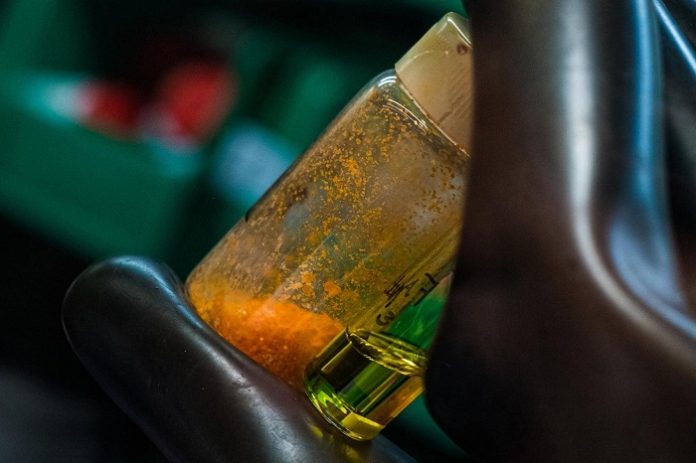Rice University engineers have created microscopic seeds for growing remarkably uniform 2D perovskite crystals that are both stable and highly efficient at harvesting electricity from sunlight.
Halide perovskites are organic materials made from abundant, inexpensive ingredients, and Rice’s seeded growth method addresses both performance and production issues that have held back halide perovskite photovoltaic technology.
In a study, chemical engineers from Rice’s Brown School of Engineering describe how to make the seeds and use them to grow homogenous thin films, highly sought materials comprised of uniformly thick layers. In laboratory tests, photovoltaic devices made from the films proved both efficient and reliable, a previously problematic combination for devices made from either 3D or 2D perovskites.
“We’ve come up with a method where you can really tailor the properties of the macroscopic films by first tailoring what you put into solution,” said study co-author. You can arrive at something that is very homogeneous in its size and properties, and that leads to higher efficiency. We got almost state-of-the-art device efficiency for the 2D case of 17%, and that was without optimization. We think we can improve on that in several ways.
Achieving homogenous films of 2D perovskites has been a huge challenge in the halide perovskite photovoltaic research community, which has grown tremendously over the past decade.
Homogeneous films are expected to lead to optoelectronic devices with both high efficiency and technologically relevant stability.
Rice’s seed-grown, high-efficiency photovoltaic films proved quite stable, preserving more than 97% of their peak efficiency after 800 hours under illumination without any thermal management. In previous research, 3D halide perovskite photovoltaic devices have been highly efficient but prone to rapid degradation, and 2D devices have lacked efficiency but were highly stable.
The Rice study also details the seeded growth process—a method that is within the reach of many labs, said study co-author Amanda Marciel, a William Marsh Rice Trustee Chair and assistant professor of chemical and biomolecular engineering at Rice.
The name perovskite refers both to a specific mineral discovered in Russia in 1839 and to any compound with the crystal structure of that mineral. For example, halide perovskites can be made by mixing lead, tin and other metals with bromide or iodide salts. Research interest in halide perovskites skyrocketed after their potential for high-efficiency photovoltaics was demonstrated in 2012.
The idea that memory or history—a genetic sort of seed—can dictate material properties is a powerful concept in materials science. A lot of templating works like this. If you want to grow a single crystal of diamond or silicon, for example, you need a seed of a single crystal that can serve as a template.
While seeded growth has often been demonstrated for inorganic crystals and other processes, this is the first time it’s been shown in organic 2D perovskites.
The process for growing 2D perovskite films from seeds is identical in several respects to the classical process of growing such films. In the traditional method, precursor chemicals are measured out like the ingredients in a kitchen—X parts of ingredient A, Y parts of ingredient B, and so on—and these are dissolved in a liquid solvent. The resulting solution is spread onto a flat surface via spin-coating, a widely used technique that relies on centrifugal force to evenly spread liquids across a rapidly spun disk. As the solvent dissolves, the mixed ingredients crystalize in a thin film.
The team has made 2D perovskite films in this manner for years, and though the films appear perfectly flat to the naked eye, they are uneven at the nanometer scale. In some places, the film may be a single crystal in thickness, and in other places, several crystals thick.
In the seeded growth method, seeds are made by slow-growing a uniform 2D crystal and grinding it into a powder, which is dissolved into solvent instead of the individual precursors. The seeds contain the same ratio of ingredients as the classical recipe, and the resulting solution is spin-coated onto disks exactly as it would be in the original method. The evaporation and crystallization steps are also identical. But the seeded solution yields films with a homogeneous, uniform surface, much like that of the material from which the seeds were ground.
The tool was dynamic light scattering, a mainstay technique in Marciel’s group. It revealed that solutions reached an equilibrium state under certain conditions, allowing a portion of some seeds to remain undissolved in solution.
The research showed those bits of seed retained the “memory” of the perfectly uniform slow-grown crystal from which they were ground, and found they could track the nucleation process that would eventually allow the seeds to produce homogeneous thin films.
The collaboration produced something that is often attempted and rarely achieved in nanomaterials research—a self-assembly method to make macroscopic materials that live up to the promise of the individual nanoparticles of which they are composed.
This is really the bane of nanomaterials technology. At an individual, single element level, you have wonderful properties that are orders of magnitude better than anything else, but when you try to put them together into something macroscopic and useful, like a film, those properties just kind of go away because you cannot make something homogeneous, with just those properties that you want.








